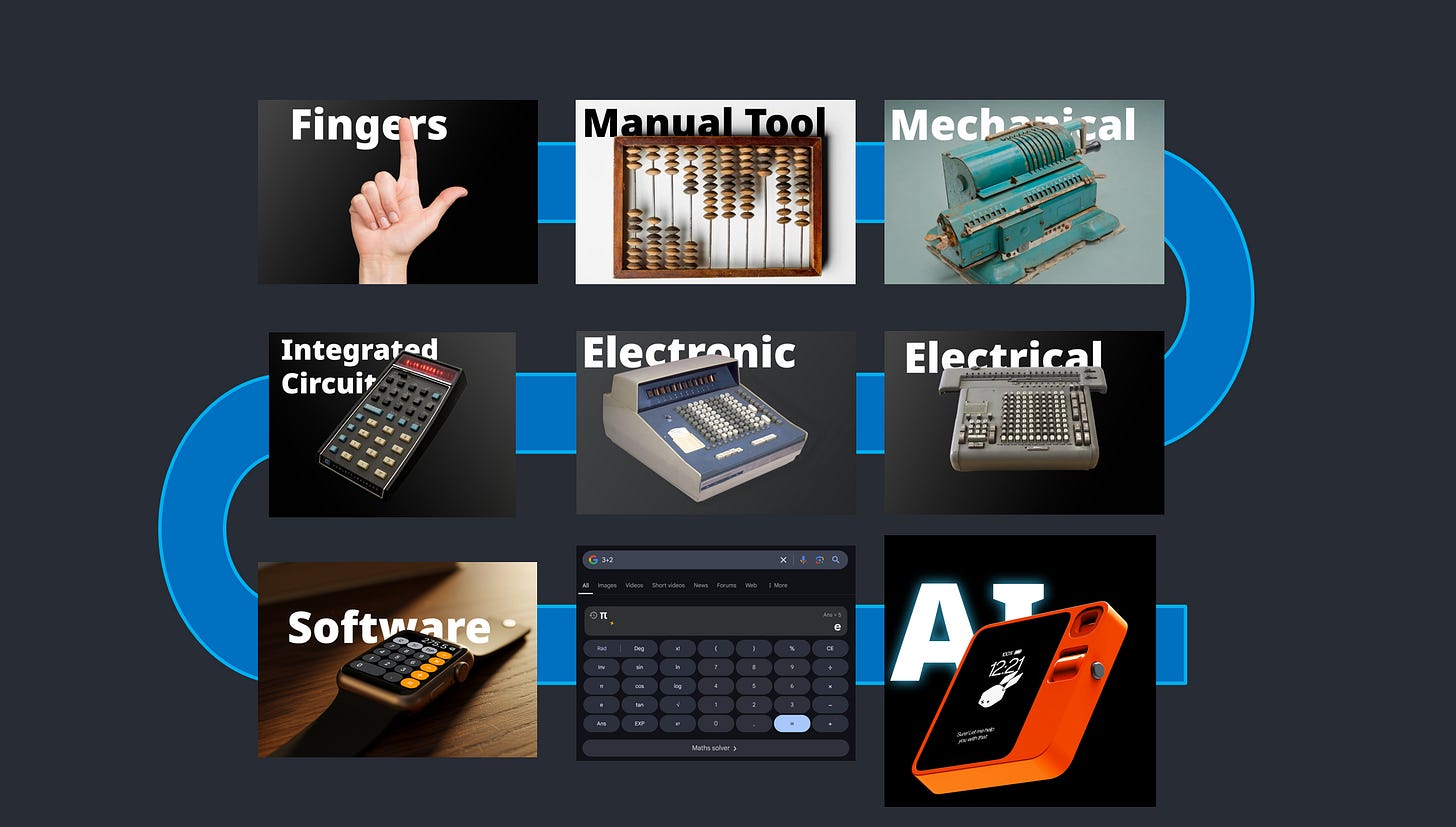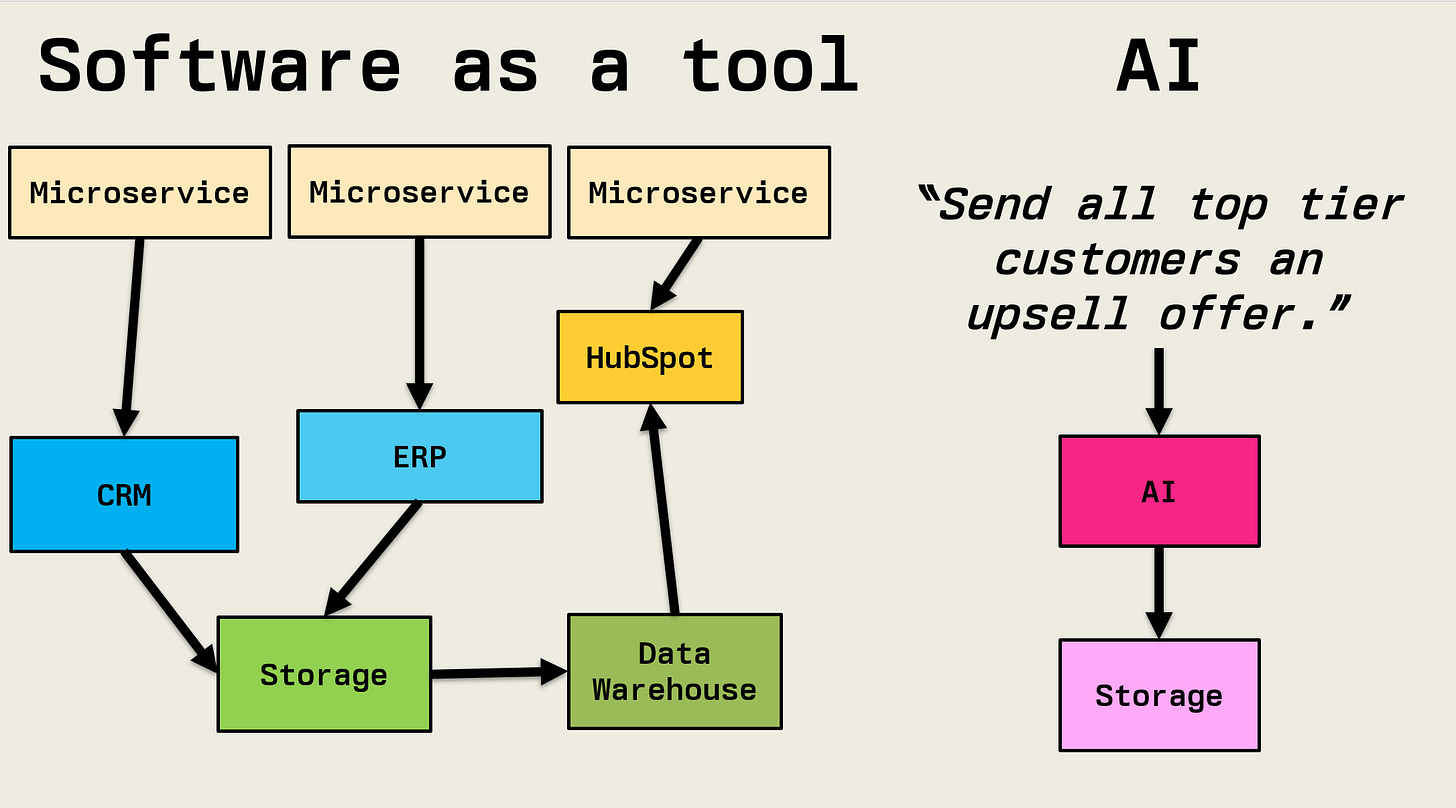AI instead of Software
How AI is replacing software
AI will replace software as a tool. We have been living with software for a long time, so we can’t imagine software going away. Software is in your phone, you use apps from the app store, software is on your computer, in your watch, your washing machine and your car. But let me tell you, it will go away just as other categories of tools went away.
Over the last ten thousand years, there always was a dominant category of tools, starting with fingers. People solved all kind of problems with their fingers, like adding numbers. New categories of tools emerged: manual, mechanical, electrical, electronic, integrated circuits (CPUs), software and most recently Saas/mobile. When building a tool, you most often chose the newest and best category. For decades this “best tool” now was software and Saas. Have a problem? Build a Saas or mobile app (or some software). But this is coming to an end, AI is the emerging best tool category.
People confuse AI with software. But AI is something different. AI is about training, not about translating requirements into logical, sequential code. AI is not software but a new category for tools that goes beyond software.
“Stephan that’s nice, but when is it going to happen? How does it look like?” I hear you say. How does it look like?
Your current tech setup might be a mix of microservices, ERP and CRM systems, external integration with tools like Hubspot and a data warehouse in the cloud. When you want to send an upsell email, you use your ERP, CRM, data and Hubspot to create, target and send the email out to potential customers who might take the upsell offer.
With AI, you have an AI running on top of storage and you tell the AI to send out that email. There is no ERP or CRM code in the AI that runs and does this. The AI will do it.
“When is it going to happen?” Lets take a look where we are we with this. To find out I’ve done some experiments with AI/LLMs in this case Claude Code with some simple games.
AI means there is no source code for doing something, instead of software running that does something. Generating source code with AI, like all developers currently do, is not AI but still software. AI means there is no source code.
This said, what works and what doesn’t? In short:
Claude Code can play Tic-Toc-Toe already.
Claude Code can play “Connect four”
Claude Code can’t play Minesweeper yet.
Start with the simplest game, Tic-Tac-Toe. Some months ago I’ve tried to play Tic-Tac-Toe against an LLM and it didn’t really work. For example, it didn’t find out that it did win, it made mistakes, didn’t understand the board.
Recently I played Tic-Tac-Toe again, no problems this time. Clean games, the LLM detected when it won. Remind you, there is no Tic-Tac-Toe game code generated or running, it’s the AI playing the game by thinking.
I did some experiments with Minesweeper in the past - e.g. letting an AI generate a Minesweeper game. That worked great! Now instead of letting the LLM generate the source code of the game to play, how did it fare with playing the game directly instead? Not so well. It sometimes worked, but it often didn’t reveal the right cells. Or it made impossible boards that could not been solved. We’re not yet able to play Minesweeper.
So let’s try something simpler, Connect4. A simple game I’ve played as a kid in the past. You still need to do some thinking, but the “physics” of the game are simpler than minesweeper.
And Claude Code had no problems playing Connect4. I won, and it didn’t play very good, but it didn’t make mistakes and made legal moves and tried to win.
This is where we stand right now, Tic-Tac-Toe and Connect4 works, Minesweeper is still too complex. But as can be seen with the Tic-Tac-Toe progression, change is fast.
Will AI replace all of software? No, it will just become the dominant tool. And like software needs ICs to run, and ICs need electronics to work, and electronics need electrical systems to work and they need a mechanical setup like screws, AI will need software to run and work.
Software will act in three different ways in this new world:
Software as glue. Software is gluing AI parts together, like we today see companies who use software glue to connect AI prompts to the UI and glue AI prompt results to storage. Like Bash glues things together.
Software as a optimization. AIs might create temporary software to speed up a solution, like a database today uses an index to speed up. A user does not see the index, but it helps make queries faster. The user does not see the generated software, or even recognize that there is any.
Software as an effector. AIs use software services to effect other systems, like an effector for sending emails or posting to the web. These effectors will also be software.
Software will stay with us, but no longer be the dominant tool to help us manage the world.
Thanks to Ingo Eichhorst for some insights.









